India in Pictures – Elephanta island
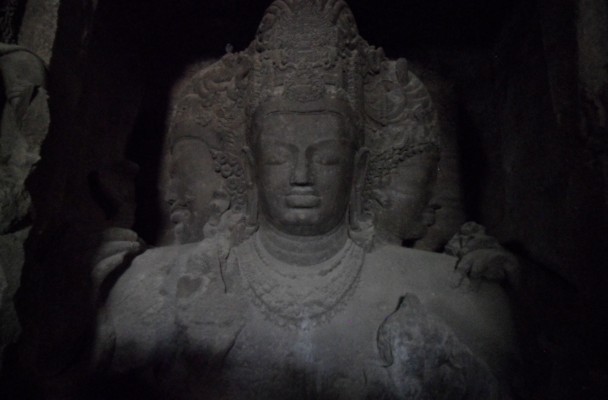
The colossal figure of Shiva with three heads dominiates the cave temple on Elephants Island
Elephanta, an island lying seven miles southeast of Mumbia, is one of many Indian temples carved into caves with some of the most amazing collections of rock-art in India. The date of Elephanta Cave is still being debated and ranges from the 6th century to the 8th century, depending on the expert.
Elephanta is reached by ferries which departure frequently from their station directly in front of the Gateway of India at the tip of Mumbia. Upon arrival in Elephanta, you board a kaboos that chucks  along to the starting point where you can either walk up 120 or so stone steps or be carried up in a make-shift chair – a la Raj style, to the cave temple at the top of the 250 feet high hill. (The price can range from $5 to $20, depending on your ability to bargain and the bearers’ perseverance.) If you walk, you will pass a steady line of stalls with the usual array of inexpensive Indian crafts and souvenirs from tiny elephants to a zillion pearl, wooden, and ceramic necklaces.
along to the starting point where you can either walk up 120 or so stone steps or be carried up in a make-shift chair – a la Raj style, to the cave temple at the top of the 250 feet high hill. (The price can range from $5 to $20, depending on your ability to bargain and the bearers’ perseverance.) If you walk, you will pass a steady line of stalls with the usual array of inexpensive Indian crafts and souvenirs from tiny elephants to a zillion pearl, wooden, and ceramic necklaces.
According to tradition, Elephanta got its name from the Portuguese in the 17th century, who found a large stone elephant at their landing site (the statue has since been moved to a museum in Mumbai)  but the local people and the ferry boatmen call the island Gharapuri which is probably the old Hindu name.
but the local people and the ferry boatmen call the island Gharapuri which is probably the old Hindu name.
The entrance to the temple, dedicated to Shiva, is an open terrace with large, thick columns about 18 feet high that were apparently, carved in situ. Directly in front and in the recesses on all three sides of the cave are finely detailed sculptures of prominent Hindu gods and their retinues carved into the walls, each depicting a story from Hindu tradition. Unfortunately, most of the carvings have been badly vandalized with hands, arms or legs partially missing.
Please note: Some of my photos are dark as we were not allowed to use flash in the cave. After I return home, I will work on them in Photo Shop and hopefully, can improve their presentation.
Dominating the temple and the most impressive sculpture in the cave at the center of the back wall is the colossal figure of Shiva with three faces. The front face, with a calm, dignified expression, is said to show Shiva as the Creator. The face on the left represents Shiva as Rudra, the Destroyer (of the evil of the universe), with a stern expression; and the face on the right as Shiva, the Preserver of the Universe.
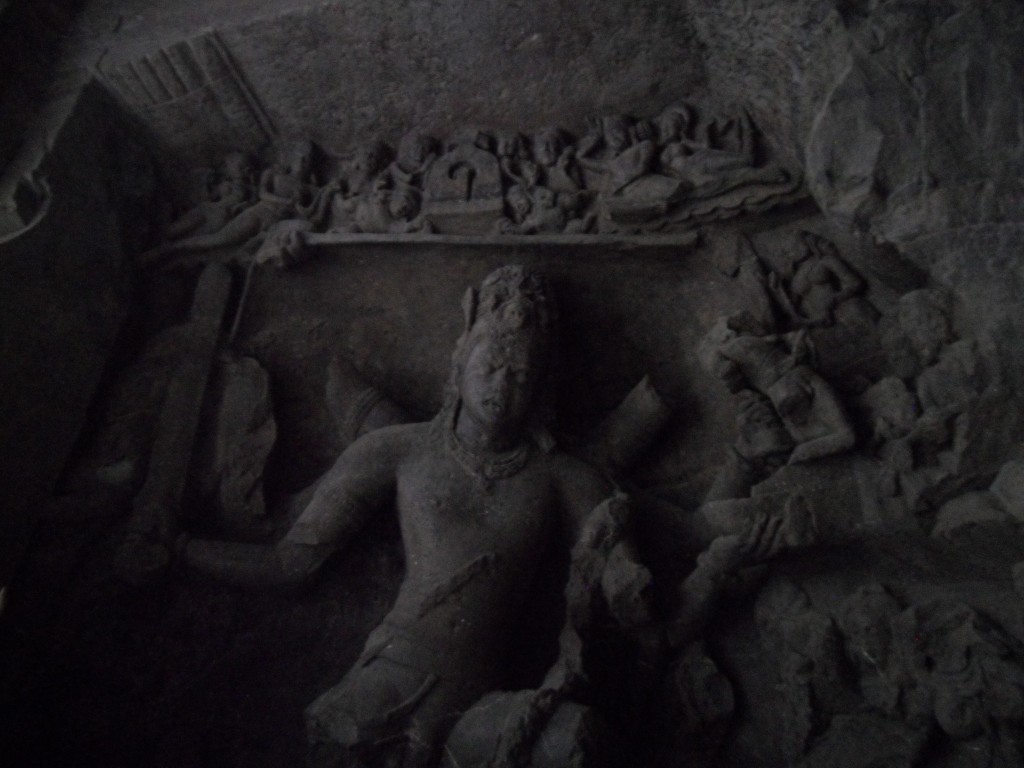 In one recess of the cave is an amazing sculpture, almost 12 feet high, showing Shiva Killing the Demon, Andhaka. The expression on Shiva’s face is fierce with his jaws clinched and his eyes bulging with rage. The original sculpture would have shown Shiva with eight arms but five are missing as are both legs. In the hand of the second arm on his right, he holds a sword ready to strike. On his left, the second hand holds a bowl, presumably to catch the blood of Andhaka who is seen pierced by Shiva’s weapon.
In one recess of the cave is an amazing sculpture, almost 12 feet high, showing Shiva Killing the Demon, Andhaka. The expression on Shiva’s face is fierce with his jaws clinched and his eyes bulging with rage. The original sculpture would have shown Shiva with eight arms but five are missing as are both legs. In the hand of the second arm on his right, he holds a sword ready to strike. On his left, the second hand holds a bowl, presumably to catch the blood of Andhaka who is seen pierced by Shiva’s weapon.
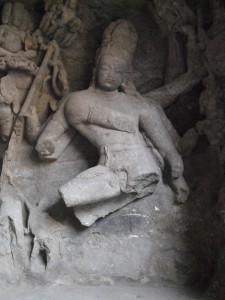 Another recess depicts Nataraja, the King of Dancers, which like the previous Shiva has eight arms of which several are missing. However, a great deal of the wonderful carving remains, for example, on the right side of Shiva is the distinctive figure of Ganesha, the elephant-headed God, one of the most popular and most frequently seen Hindu gods in temple sculpture. Below Ganesha is Bhiringi, an attendant of
Another recess depicts Nataraja, the King of Dancers, which like the previous Shiva has eight arms of which several are missing. However, a great deal of the wonderful carving remains, for example, on the right side of Shiva is the distinctive figure of Ganesha, the elephant-headed God, one of the most popular and most frequently seen Hindu gods in temple sculpture. Below Ganesha is Bhiringi, an attendant of 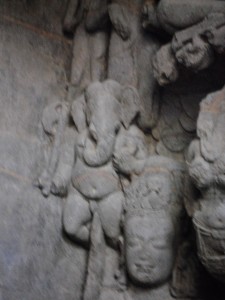 Shiva in the same dancing posture as his master.
Shiva in the same dancing posture as his master.
A shrine in the form of a male organ meant to symbolize the union of man and woman and a symbol of Shiva is set in a separate room with doorways on each side where very large figures stand guard on the outside. Apparently, it draws large numbers of Shiva devotees annually in February during a special Hindu festival. During my visit, I saw worshippers place flora offerings on the shrine.
The most exquisite carvings are the scene of the Marriage of Shiva and Parvati. In it, a smiling Shiva is extending his right arm to receive the hand of Parvati (which unfortunately is missing). The lovely figure of Parvati, not yet married, is on the right side of Shiva in keeping with Hindu custom. (In another carving after marriage, she is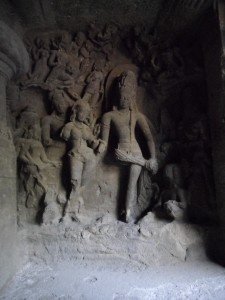 pictured on the left side of Shiva.) The Parvati sculpture stands 8.5 feet high although next to the
pictured on the left side of Shiva.) The Parvati sculpture stands 8.5 feet high although next to the
Before returning to the stairway to depart, you’ll probably want to walk in the wooded area by the temple to enjoy the view overlooking the island down to the sea and to watch a family of monkeys scrampering about. Signs warn to beware of the monkeys who are 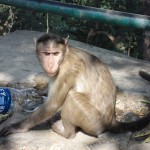 known to be pests.
known to be pests.
(Most of the descriptions of the Hindu gods above were provided by my guide during my visit to Elephanta Island and from A Guide Book of Elephanta, A World Heritage Monument, with text by Dr. Rajaram Panda, published by Mittal Publising, India. The small book is available for sale at the moment.
By Kay Showker, at sea on the Nautica of Oceania Cruises
